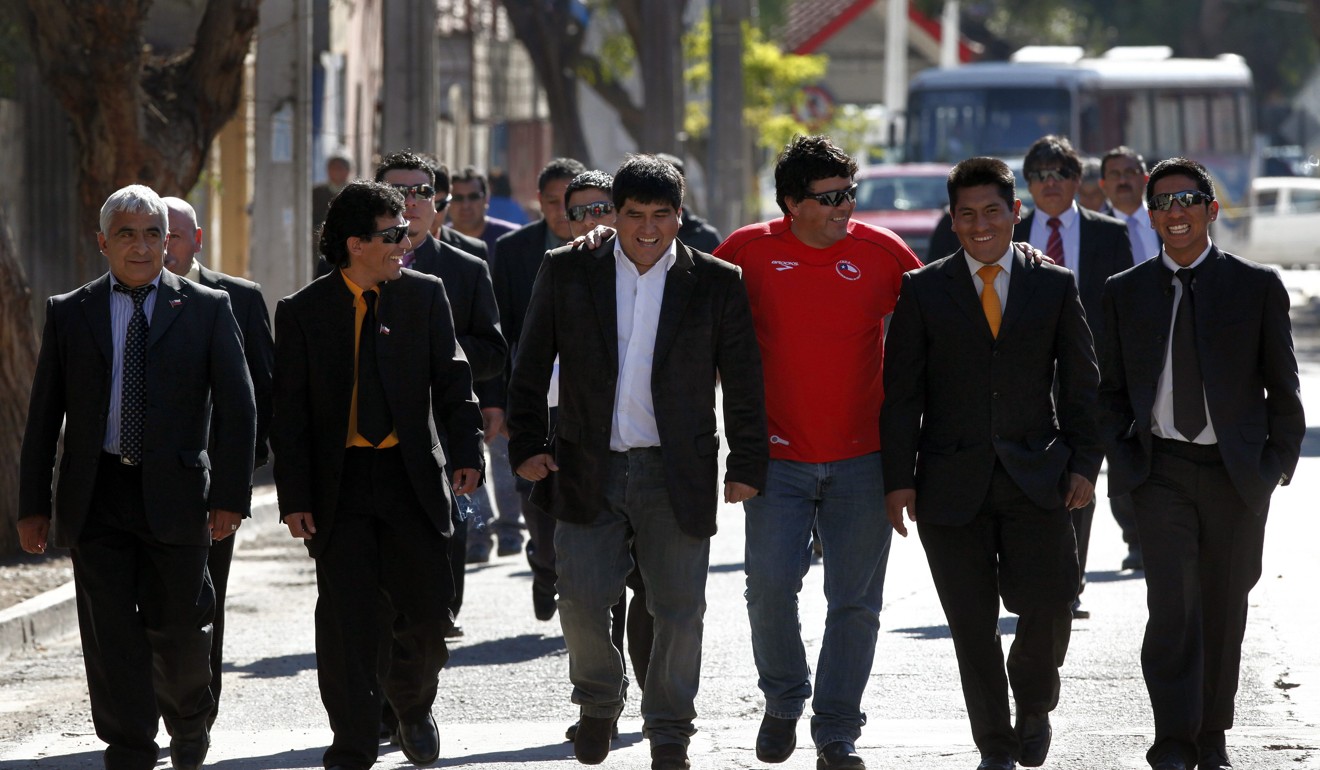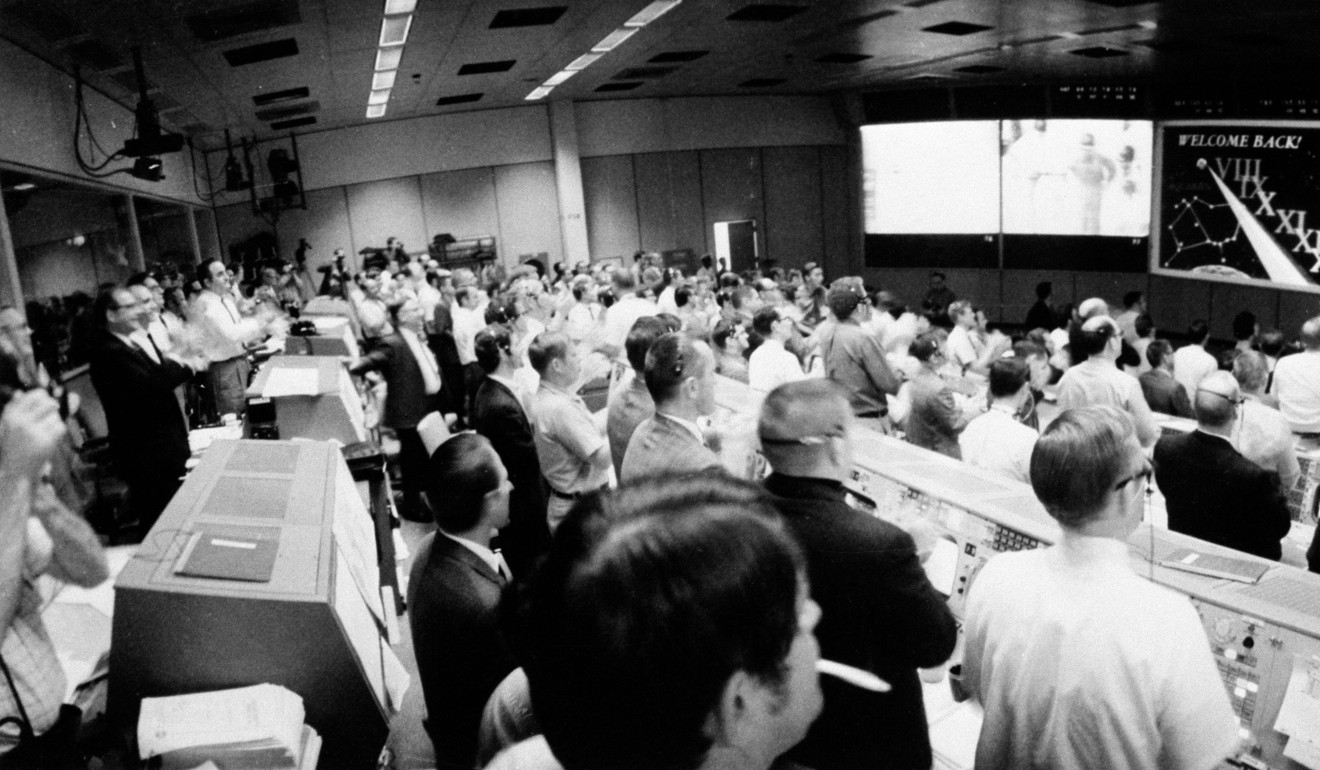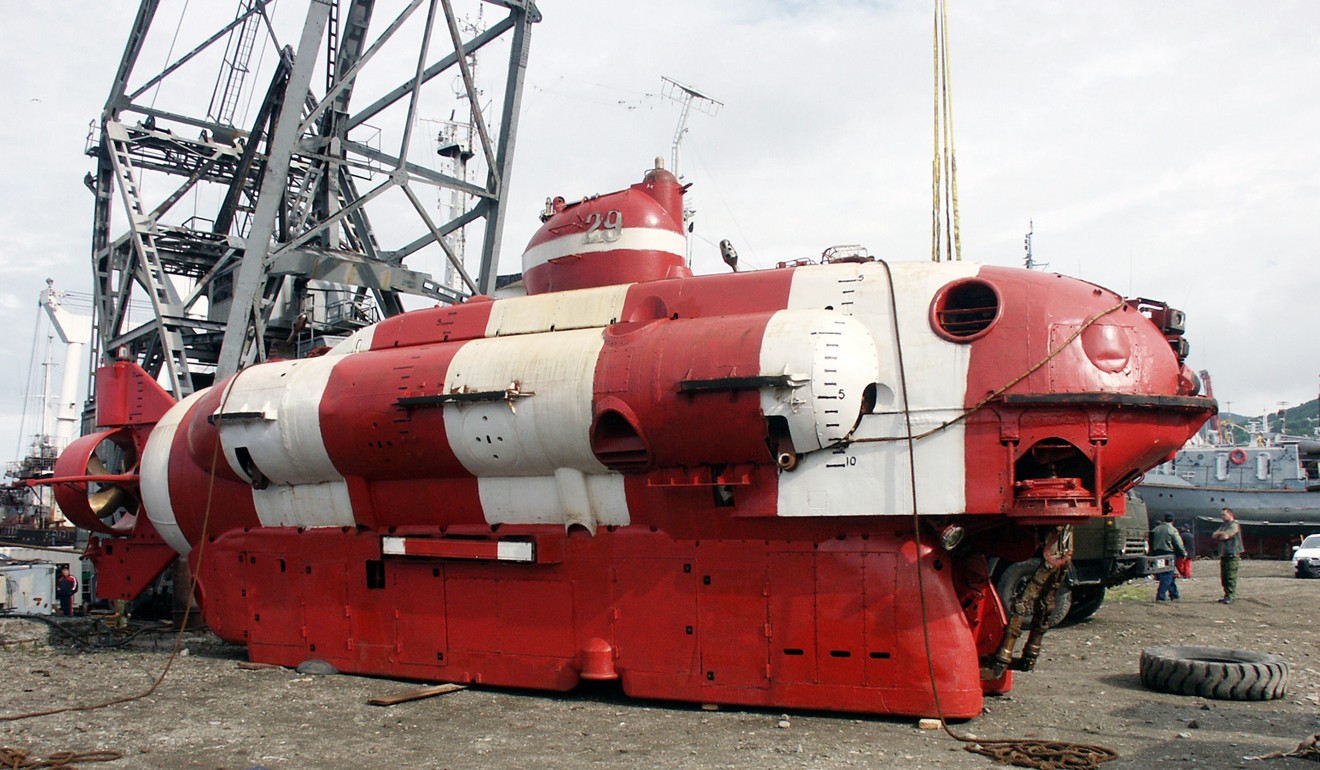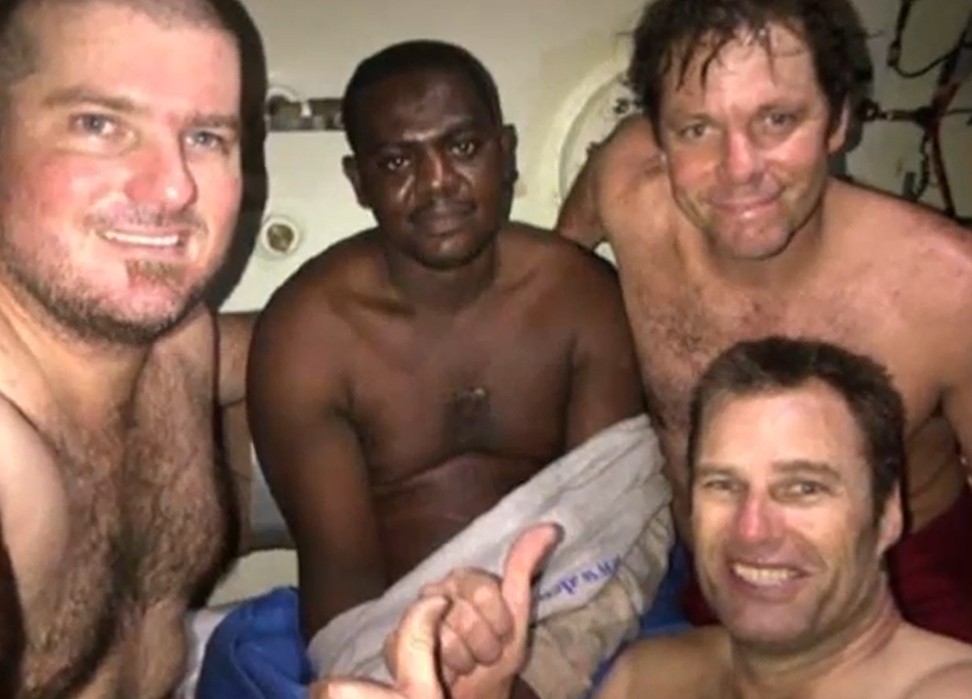
Nine rescues that give hope to the boys found in Thailand cave – and prove miracles do happen
From the Chilean mining incident to the Miracle on the Hudson to the Apollo 13 sensation, we look at stunning rescue missions that give Thailand’s people hope 12 boys and their soccer coach trapped by floodwaters will make it out
On Monday, after a painstaking search by specialist divers, the emaciated group were discovered on a mud embankment, and the incredible moment when divers made contact with them was captured on a video released by Thai Navy SEALs.
There had been no contact with the boys, aged between 11 and 16, since they went missing with their 25-year-old coach on June 23, and the massive international rescue effort had for days been hampered by heavy rains that flooded the Tham Luang cave in northern Thailand.
Now the focus shifts to the arduous task of extracting the group from the winding chambers and narrow passageways of the 10-kilometre-long (6-mile-long) Tham Luang complex. Rescuers said on Tuesday they plan to supply the boys with up to four months’ food while a rescue can be planned, indicating the soccer team’s stay underground – and their families’ agonising wait on the surface – may not be over just yet.
But it proves miracles can still happen, and when they take do, the world is suddenly a better place. Here are nine other stirring rescue operations that brought together communities and captivated millions around the world.
How the Thailand cave rescue unfolded
1. Andes flight disaster (1972)
On October 13, 1972, a chartered flight carrying a Uruguayan rugby team and a group of their friends and family members crashed into a mountain in the Argentine Andes. Of the 45 passengers on board, 12 were killed in the crash, and half a dozen others died in the days that followed.
On October 29, an avalanche struck their shelter, killing eight more people, and with no food left, the survivors resorted to eating their dead teammates and acquaintances.
Eventually two passengers, Nando Parrado and Roberto Canessa, set out on a 12-day trek across the mountains to seek help in Chile. Thanks to the duo’s bravery and determination, the last 14 survivors were rescued after 72 days on a remote mountaintop. The incident was the subject of the 1993 film Alive, starring Ethan Hawke.

2. Chilean mining accident (2010)
On October 13, 2010, one billion people tuned in to watch live on TV the successful rescue of 33 Chilean miners who had been trapped underground for 69 days. The disaster began on Thursday, August 5, 2010, around lunchtime at a mine in Chile’s Atacama Desert, when miners working deep inside a mountain, excavating for copper, gold and other minerals, started feeling vibrations.
Suddenly, there was a massive explosion and when the dust settled the miners found they were sealed inside the mountain by a “megablock” of fallen stone, some 770,000 tons of it, “twice the weight of the Empire State building”.

The search effort immediately began, with a rescue team drilling exploratory boreholes, and 17 days after the accident a note was found taped to a drill bit pulled back to the surface: “Estamos bien en el refugio, los 33” (“We are well in the shelter, the 33 of us”).
On October 13, 2010, all 33 of those Chilean miners trapped inside the San Jose Mine were raised to the surface through a newly drilled escape tunnel, using a capsule that was slowly lowered and raised by a giant crane. It was a feat of engineering and a triumph of faith.
The rescue was the subject of a 2015 feature film, The 33 .

3. Apollo 13 (1970)
“Houston, we’ve had a problem” are the immortal words – constantly misquoted – synonymous with another amazing rescue. They will forever be connected with the Apollo 13 spaceship that was rocked by an explosion on April 13, 1970, when an oxygen tank blew up, disabling the spaceship’s electrical system.
The third lunar landing mission, carrying astronauts James A. Lovell, John L. Swigert, and Fred W. Haise, quickly became a fight for survival for the three men on board. It set off an intense rescue operation from mission control in Houston, who guided and monitored the spacecraft for the next three days.

Engineers on the ground scrambled to develop a procedure that would allow the astronauts to restart the badly damaged command module for re-entry. Miraculously, their solution worked, and the crew splashed down safely into the Pacific Ocean on April 17. It was a drama that unfolded in real time for millions of people around the world, and decades later, was dramatised in the 1995 film Apollo 13, starring Tom Hanks.
4. Miracle on the Hudson (2009)
A minute after taking off from New York’s La Guardia Airport on January 15, 2009, US Airways Flight 1549 collided with a flock of geese. The bird strike crippled both engines and left Captain Chesley Burnett Sullenberger III with no other option but to make an emergency landing – into the Hudson river.
Minutes later Sullenberger glided the Airbus 320 over the George Washington Bridge and onto the chilly surface of the Hudson River, where it splashed down midway between Manhattan and New Jersey.

As flight attendants ushered passengers into life jackets, through emergency exits and onto the waterlogged wings of the bobbing jet, a flotilla of commuter ferries, sightseeing boats and rescue vessels hastened to the scene.
Despite one survivor suffering two broken legs and others treated for minor injuries or hypothermia, miraculously there were no fatalities.
Clint Eastwood directed Tom Hanks in a feature film dramatisation of the rescue and its aftermath, Sully .

5. Kamchatka Peninsula submarine crisis (2005)
The seven-man crew of a Russian Priz mini-submarine were running out of air after three days trapped underwater when they were finally rescued. Their submarine became entangled in marine debris on August 4, 2005, and the Russian crew was powerless to move from the position around 190 metres (625 feet) below the ocean surface.
The incident immediately drew comparisons with Russia’s Kursk submarine accident five years earlier, which ended in tragedy with the deaths of all 118 crew. But the Priz crew were rescued after a British undersea robot cut the vessel free.
Russian President Vladimir Putin awarded medals to the British team who rescued the submarine crew and Moscow announced it would purchase several of the type of underwater robot used in the rescue.

6. Trapped in an air pocket in a sunken boat 30 metres underwater
Who can forget the story of Harrison Okene, a 28-year-old cook on board the Jascon 4, a tug that capsized in 2013 while it was stabilising an oil tanker in heavy seas, 32km off the Nigerian coast. The tug turned upside-down and dropped to the sea floor 30m below. Harrison, who was in the toilet, felt the boat beginning to turn over and managed to find an air pocket as it sank.
“I heard people shouting, I felt the vessel going down, going down, I heard a voice saying ‘Is this vessel sinking or what?’ … I was in the WC (toilet) and the WC fell on my head, things started falling on my head … My colleagues were shouting ‘God help me, God help me, God help me.’ Then after a while I never heard from them (again).

“I was there in the water in total darkness just thinking it’s the end. I kept thinking the water was going to fill up the room but it did not,” he said. Harrison could hear fish feeding on his dead crewmates.
Three days later he heard knocking on the hull and was shocked when a diver shone a light through the water. Not as shocked as the diver was when he felt Harrison’s hand on his shoulder.
There were 12 people on board, but he was the only survivor.
After 60 hours at such a depth, Harrison had to endure another 60 hours in a decompression chamber before rejoining the world. Unsurprisingly he still gets nightmares about the incident.

7. A toddler stuck down a well
In October 1987, 18-month-old Jessica McClure fell down a well in her aunt’s back garden.
She was trapped in an 23cm well casing seven metres into the ground. The local fire and police departments devised a plan to drill down parallel to the well and then dig horizontally to it. They called in local oil drillers and expected to free Jessica in a matter of minutes.
Unfortunately their drills were barely able to cut through the rock around the well. After six hours they had drilled the shaft. It took even longer to drill the connecting tunnel. A mining expert arrived and coordinated the rescue. The rescuers could hear Jessica singing Winnie the Pooh, confirming she was still alive.

Fifty-eight hours after she fell in, a paramedic, Robert O’Donnell was able to free her. Jessica had to have a toe amputated, due to gangrene caused by loss of circulation. She underwent 15 further operations. She has no memory of the ordeal. This rescue was one of the first times water jet cutting equipment was used.
8. Shandong mining disaster (2016)
More recently and much closer to home, another incident captivated China when four miners were rescued on January 29, 2016, after 36 days trapped in a collapsed gypsum mine in eastern Shandong province. It was believed to be China’s longest-ever rescue operation, state media reported.
After rescuers finally established contact with the four remaining trapped miners out of 17 that had gone missing, they passed food, clothes, medicine and torches down to them while continuing to drill additional ventilation shafts and boreholes.
However, attempts to create a tunnel wide enough to extract the miners trapped 200 metres beneath the surface were constantly hampered by additional rockfalls and structural hazards. The massive 36-day rescue operation involved hundreds of industry professionals, the army, military police and the fire service, with the four miners eventually being rescued.
Daring T8 helicopter rescue saves sinking ship’s crew
9. Typhoon helicopter rescue in Hong Kong (2014)
The rescue operation was mounted when the 96-metre-long cargo ship Hao Jun lost power in Chinese waters about 20km southwest of Macau. The ship’s master ordered the 13 other crew members to abandon ship as it was taking on water and in danger of sinking, just as the No 8 signal was raised as Typhoon Kalmaegi barrelled towards Guangdong and Hainan island, bringing with it gusts of up to 166km/h.
A Government Flying Service Super Puma helicopter was dispatched to rescue the crew after Guangdong maritime rescue authorities sought help from their Hong Kong counterparts. Despite being battered by 10-metre waves and buffeted by wind gusts of over 100 km/h that made plucking the sailors from the ship and winching them to safety even more difficult, all were safely rescued. It took rescuers about an hour to collect the 14 crew members, who were then airlifted to Hong Kong, with only one crew member requiring hospital treatment.

